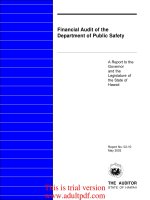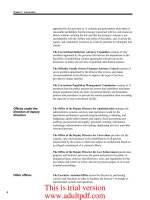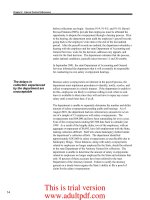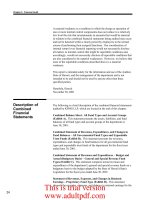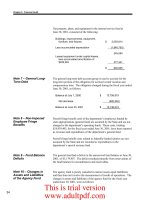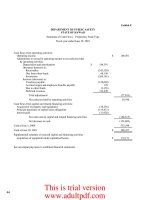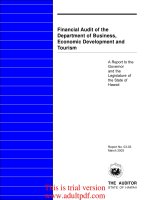Financial Audit of the Department of Public Safety A Report to the Governor and the Legislature _part4 pptx
Bạn đang xem bản rút gọn của tài liệu. Xem và tải ngay bản đầy đủ của tài liệu tại đây (159.26 KB, 10 trang )
24
Chapter 3: Financial Audit
A material weakness is a condition in which the design or operation of
one or more internal control components does not reduce to a relatively
low level the risk that misstatements in amounts that would be material
in relation to the combined financial statements being audited may occur
and not be detected within a timely period by employees in the normal
course of performing their assigned functions. Our consideration of
internal control over financial reporting would not necessarily disclose
all matters in internal control that might be reportable conditions and,
accordingly, would not necessarily disclose all reportable conditions that
are also considered to be material weaknesses. However, we believe that
none of the reportable conditions described above is a material
weakness.
This report is intended solely for the information and use of the Auditor,
State of Hawaii, and the management of the department and is not
intended to be and should not be used by anyone other than these
specified parties.
Honolulu, Hawaii
November 30, 2001
The following is a brief description of the combined financial statements
audited by KPMG LLP, which are located at the end of this chapter.
Combined Balance Sheet– All Fund Types and Account Groups
(Exhibit A). This statement presents the assets, liabilities, and fund
balances of all fund types and account groups of the department at
June 30, 2001.
Combined Statement of Revenues, Expenditures, and Changes in
Fund Balances – All Governmental Fund Types and Expendable
Trust Funds (Exhibit B). This statement presents the revenues,
expenditures, and changes in fund balances for all governmental fund
types and expendable trust funds of the department for the fiscal year
ended June 30, 2001.
Combined Statement of Revenues and Expenditures – Budget and
Actual (Budgetary Basis) – General and Special Revenue Fund
Types (Exhibit C). This statement compares actual revenues and
expenditures of the department’s general and special revenue funds on a
budgetary basis to the budget adopted by the State of Hawaii (State)
Legislature for the fiscal year ended June 30, 2001.
Statement of Revenues, Expenses, and Changes in Retained
Earnings – Proprietary Fund Type (Exhibit D). This statement
presents the revenues, expenses, and changes in retained earnings for the
Description of
Combined
Financial
Statements
This is trial version
www.adultpdf.com
25
Chapter 3: Financial Audit
proprietary fund type of the department for the fiscal year ended June 30,
2001.
Statement of Cash Flows – Proprietary Fund Type (Exhibit E). This
statement presents the cash flows from operating and capital and related
financing activities for the proprietary fund type of the department for
the fiscal year ended June 30, 2001.
Explanatory notes which are pertinent to an understanding of the
combined financial statements and financial condition of the department
are discussed in this section.
Effective July 1, 1990, Act 281, Session Laws of Hawaii (SLH) 1990,
created the department. This act transferred to the department, the
administration of the state correctional facilities and related services
formerly administered by the state Department of Corrections. This act
also transferred to the department on July 1, 1990, all functions and
powers to administer the Sheriff’s Office – formerly administered by the
state Judiciary, and the Narcotics Enforcement Division – formerly
administered by the state Department of the Attorney General.
The department is part of the executive branch of the State. The
department’s combined financial statements reflect only its portion of the
funds and account groups. The state comptroller maintains the central
accounts for all state funds and publishes financial statements for the
State annually, which includes the department’s financial activities.
The accompanying combined financial statements reflect the financial
position, results of operations, and cash flows of the following offices,
divisions, and administratively attached agencies of the department:
Office of the Deputy Director for Administration – Administration
includes management, accounting, data processing, and other
administrative services provided by the department. Also included in
administration are activities related to certain federal financial assistance
programs. Its operations are reported in both the general and special
revenue funds.
Office of the Deputy Director for Law Enforcement – Law
enforcement assists in guarding state property and facilities, preserving
the peace and protecting the public in designated areas, and serving
process papers in civil and criminal proceedings. Included in law
enforcement are the Protective Services, Narcotics Enforcement, and
Notes to
Combined
Financial
Statements
Note 1 – Financial
Reporting Entity
This is trial version
www.adultpdf.com
26
Chapter 3: Financial Audit
Sheriff Divisions, and the Executive Protection Section. Its operations
are reported in both the general and special revenue funds.
Community Correctional Centers Division – This division operates
the state community correctional centers. Its public safety mission
includes the confinement, care, supervision, rehabilitation, and release of
persons committed to those facilities. Its operations are reported in both
the general and trust and agency funds.
Correctional Facilities Division – This division operates the state
correctional facilities other than the state community correctional
centers. Its public safety mission includes the confinement, care,
supervision, rehabilitation, and release of persons committed to those
facilities. Its operations are reported in both the general and trust and
agency funds.
Inmate Stores – The inmate stores are operated by the department
within the Community Correctional Centers and Correctional Facilities
Divisions. The department contracts with an outside vendor to provide
consumer goods for sale to the inmate population. The stores’ operations
are reported in the special revenue fund.
Intake Service Centers Division – This division provides service
delivery coordination to the state's criminal justice agencies through
intake, assessment, program services, and administrative functions. Its
operations are reported in both the general and special revenue funds.
Corrections Program Services Division – This division develops
operational guidelines and standards and provides technical and
administrative support and assistance to all correctional facilities for the
effective and efficient conduct of programs and services. It also assists
in coordinating and maintaining oversight of institutional operations,
programs, and services. Its operations are reported in both the general
and special revenue funds.
Health Care Division – This division develops and maintains a program
of health care services involving both in-house and community resources
(public health, contract, and volunteer) for all correctional facilities. It
also oversees the operation of such services to ensure adherence to
contemporary standards and fiscal responsibility, uniformity of quality
health care, and integration/coordination among health care providers.
Its operations are reported in the general fund.
Correctional Industries Division – This division employs inmates who
receive employment training and who provide printing, sewing,
construction, and miscellaneous services to other operations of the
department or other state agencies. Its operations are reported in the
internal service fund.
This is trial version
www.adultpdf.com
27
Chapter 3: Financial Audit
Crime Victims Compensation Commission (administratively
attached to the department) – This commission assists victims of
criminal acts by providing compensation to victims or survivors of
deceased victims of certain crimes. Its operations are reported in the
special revenue fund.
Hawaii Paroling Authority (administratively attached to the
department) – This authority is a quasi-judicial body that establishes
minimum terms of imprisonment, considers requests for parole, and
provides supervision for those granted parole. Its operations are reported
in the general fund.
Basis of Presentation
The financial transactions of the department are recorded in individual
funds and account groups, reported by type in the combined financial
statements, and described in the following sections. Each fund and
account group is considered a separate accounting entity. The operations
of each are accounted for with a separate set of self-balancing accounts
that comprise its assets, liabilities, fund balances, retained earnings,
revenues, and expenditures or expenses. Account groups are used to
establish accounting control and accountability for the department’s
general fixed assets and general long-term debt. Account groups are not
funds as they do not reflect available financial resources and related
liabilities. Financial resources are allocated to and are accounted for in
individual funds based upon the purposes for which they are to be spent
and the means by which spending activities are controlled.
Governmental Fund Types
General Fund – The general fund is the general operating fund of the
department. It is used to account for all financial activities except those
required to be accounted for in another fund. The annual operating
budget as authorized by the State Legislature provides the basic
framework within which the resources and obligations of the general
fund are accounted.
Special Revenue Funds – Special revenue funds are used to account for
the proceeds of specific revenue sources (other than expendable trusts)
that are restricted to expenditures for specified purposes.
Capital Projects Fund – The capital projects fund is used to account for
financial resources to be used for the acquisition or construction of major
capital facilities.
Note 2 – Summary of
Significant Accounting
Policies
This is trial version
www.adultpdf.com
28
Chapter 3: Financial Audit
Proprietary Fund Type
Internal Service Fund – The internal service fund accounts for the
financing of goods or services provided by this fund to other funds of the
department or to other state agencies, on a cost-reimbursement basis.
Fiduciary Fund Type
Trust and Agency Funds – Trust and agency funds are used to account
for assets held by the department in a trustee or agency capacity. These
include expendable trust funds that account for cash collected and
expended by the department as trustee and agency funds that account for
the receipts and disbursements of various amounts collected by the
department in a custodial capacity.
Account Groups
General Fixed Assets Account Group – General fixed assets acquired for
use by the department in the conduct of its general governmental
operations are accounted for in the general fixed assets account group at
cost or the estimated fair market value on the date of donation.
Accumulated depreciation is not recorded in the general fixed assets
account group.
General Long-Term Debt Account Group – The obligation for the long-
term portion of accrued vested vacations and compensatory time is
recorded in the general long-term debt account group.
Basis of Accounting
Governmental Fund Types and Expendable Trust and Agency Funds –
The accounting and financial reporting treatment applied to a fund is
determined by its measurement focus. All governmental funds and
expendable trust funds are accounted for using a current financial
resources measurement focus. With this measurement focus, only
current assets and current liabilities are generally included on the
combined balance sheet. Operating statements of these funds present
increases (i.e., revenues and other financing sources) and decreases (i.e.,
expenditures and other financing uses) in net current assets.
The department uses the modified accrual basis of accounting for the
general, special revenue, capital projects, expendable trust, and agency
funds. Under the modified accrual basis of accounting, revenues and
related current assets are recognized in the accounting period when they
become both measurable and available to finance operations of the fiscal
year or liquidate liabilities existing at fiscal year-end. Measurable means
that the amount of the transaction can be determined. Available means
that the amount is collected in the current fiscal year or soon enough
after fiscal year-end to liquidate liabilities existing at the end of the fiscal
This is trial version
www.adultpdf.com
29
Chapter 3: Financial Audit
year. Revenues susceptible to accrual include federal grants and funds
appropriated by the State Legislature and allotted by the governor.
Expenditures are generally recorded when the related fund liabilities are
incurred.
Proprietary Fund Type – The proprietary fund type, the internal service
fund, is accounted for on the flow of economic resources measurement
focus. With this measurement focus, all assets and liabilities associated
with the operation of this fund are included on the combined balance
sheet. Proprietary fund-type operating statements present increases (i.e.,
revenues) and decreases (i.e., expenses) in net total assets.
The accounts of the propriety fund type are reported under the accrual
basis of accounting. Under the accrual basis of accounting, revenues are
recognized when they are earned and expenses are recorded when they
are incurred. The department applies all Financial Accounting Standards
Board pronouncements on accounting and financial reporting that were
issued on or before November 30, 1989.
Use of Estimates
The preparation of combined financial statements in conformity with
accounting principles generally accepted in the United States of America
(GAAP) requires management to make estimates and assumptions that
affect the reported amounts of assets and liabilities and disclosures of
contingent assets and liabilities at the date of the combined financial
statements and the reported amounts of revenues and expenditures or
expenses during the reporting period. Actual results could differ from
those estimates.
Appropriations
Appropriations represent the authorizations granted by the State
Legislature that permit a state agency, within established fiscal and
budgetary controls, to incur obligations and to make expenditures.
Appropriations are allotted quarterly. The allotted appropriations lapse
if not expended by or encumbered at the end of the fiscal year.
Encumbrances
Encumbrance accounting, under which purchase orders, contracts, and
other commitments for the expenditure of moneys are recorded in order
to reserve that portion of the applicable appropriation, is employed as an
extension of formal budgetary integration in the governmental fund
types. Encumbrances outstanding at fiscal year-end are reported as
reservations of fund balances since they do not constitute expenditures or
liabilities.
This is trial version
www.adultpdf.com
30
Chapter 3: Financial Audit
Accumulated Vacation and Sick Leave
Employees’ vested annual vacation and sick leave are recorded as
expenditures when actually taken. The employees of the department are
entitled to receive cash payment for accumulated vacation leave upon
termination. The liability for such accumulated vacation leave pay and
related payroll taxes is not reflected in the governmental funds, but is
reflected in the general long-term debt account group. Sick leave is not
convertible to pay upon termination of employment and is recorded as an
expenditure when taken.
Intrafund and Interfund Transactions
Significant transfers of financial resources between activities included
within the same fund are offset within that fund. Transfers of revenues
from funds authorized to receive them to funds authorized to expend
them have been recorded as operating transfers in the combined financial
statements.
Receivables
Receivables in the general fund represent amounts due from individuals
for whom salaries were overpaid by the department. Receivables in the
internal service fund consist primarily of amounts due from other state
agencies for services provided to those agencies on a cost-reimbursement
basis.
Inventories
Inventory of goods, materials, and supplies is valued at cost (first-in,
first-out method). Inventory in the internal service fund consists
primarily of printing, construction, sewing, and computer supplies to be
used in the correctional industries program.
Net Property, Plant, and Equipment
Property, plant, and equipment reported in the general fixed assets
account group are recorded at cost. Those assets were acquired or
constructed for general governmental purposes and were reported as
expenditures in the funds that financed the assets at acquisition. No
depreciation is provided on those assets.
Property, plant, and equipment reported in the internal service fund are
recorded at cost, net of accumulated depreciation. Depreciation of
equipment has been provided using the straight-line method over a five-
year estimated useful life of the related assets. Capital improvements
have been depreciated over a 40-year estimated useful life.
This is trial version
www.adultpdf.com
31
Chapter 3: Financial Audit
Due to Individuals
Due to individuals represents assets held by the department primarily in
a trustee capacity for the inmate population.
Grants
Federal grants and assistance awards made on the basis of entitlement
periods are recorded as intergovernmental receivables and revenues
when entitlement occurs. All other federal reimbursement-type grants
are recorded as intergovernmental receivables and revenues when the
related expenditures or expenses are incurred.
Risk Management
The department is exposed to various risks for losses related to torts;
theft of, damage to, or destruction of assets; errors or omissions; natural
disasters; and injuries to employees. A liability for a claim for a risk of
loss is established if information indicates that it is probable that a
liability has been incurred at the date of the combined financial
statements and the amount of the loss is reasonably estimable.
Total Columns on the Combined Financial Statements
The total columns are captioned Memorandum Only to indicate that they
are presented only to facilitate financial analysis. Data in those columns
do not present financial position, results of operations, or cash flows in
conformity with GAAP. Neither is such data comparable to a
consolidation. Interfund eliminations have not been made in the
aggregation of this data.
Revenue estimates are provided to the State Legislature at the time of
budget consideration and are revised and updated periodically during the
fiscal year. Amounts reflected as budgeted revenues in the combined
statement of revenues and expenditures – budget and actual (budgetary
basis) – general and special revenue fund types are those estimates as
compiled by the department. Budgeted expenditures are derived
primarily from acts of the State Legislature and from other authorizations
contained in other specific appropriation acts in various SLH.
To the extent not expended or encumbered, general fund appropriations
generally lapse at the end of the fiscal year for which the appropriations
were made. The State Legislature specifies the lapse date and any other
particular conditions relating to terminating the authorization for other
appropriations.
Summarization of the budgets adopted by the State Legislature for the
“budgetary” general and special revenue funds is presented in the
combined statement of revenues and expenditures – budget and actual
Note 3 – Budgeting and
Budgetary Control
This is trial version
www.adultpdf.com
32
Chapter 3: Financial Audit
(budgetary basis) – general and special revenue fund types. For purposes
of budgeting, the department’s budgetary fund structure and accounting
principles differ from those utilized to present the combined financial
statements in conformity with GAAP. The department’s annual budget
is prepared on the modified accrual basis of accounting with several
differences, principally related to (1) the encumbrance of purchase order
and contract obligations, (2) the recognition of certain receivables, and
(3) special revenue fund program grant accruals and deferrals. These
differences represent a departure from GAAP. The following schedule
reconciles the budgetary amounts to the amounts presented in accordance
with GAAP for the fiscal year ended June 30, 2001:
Cash consisted of the following as of June 30, 2001:
The state Director of Finance is responsible for safekeeping of all
moneys paid into the State Treasury (cash pool). The state Director of
Finance is authorized to invest in obligations of or guaranteed by the
U.S. Government, obligations of the State, federally-insured savings and
checking accounts, time certificates of deposit, and repurchase
agreements with federally-insured financial institutions. Cash and
deposits with financial institutions are collateralized in accordance with
State statutes. Deposits not covered by federal deposit insurance are
General
Special
Revenue
Excess (deficiency) of revenues and
other sources over expenditures and
other uses – actual on a budgetary
basis
$ (1,735,106) $ 424,639
Reserved for encumbrances at fiscal
year-end 5,371,833 399,180
Reserved for receivables 1,169,426 —
Expenditures for liquidation of prior fiscal
year encumbrances
(7,944,242) (198,172)
Net change in unreserved liabilities (43,765) (80,825)
Net adjustment for commissary revenue
accrual — (31,805)
Net adjustment for grant accruals — 28,021
Excess (deficiency) of revenues and
other sources over expenditures and
other uses – GAAP basis
$ (3,181,854) $ 541,038
Note 4 – Cash
Cash in State Treasury $ 15,129,406
Cash in banks 994,561
Cash on hand 23,950
$ 16,147,917
This is trial version
www.adultpdf.com
33
Chapter 3: Financial Audit
fully collateralized by government securities held either by the State
Treasury or by the State’s fiscal agents in the name of the State.
The department also maintains cash in banks which are held separately
from cash in the State Treasury. As of June 30, 2001, the carrying
amount of total bank deposits was approximately $994,561, and the
corresponding bank balance was approximately $1,233,683.
Receivables of the department, net of an allowance for doubtful
accounts, consisted of the following at June 30, 2001:
The changes in the general fixed assets (unaudited) were as follows:
Note 5 – Receivables
General
Internal
Service
Salary overpayments $ 1,767,426 $ —
Accounts receivable — 898,892
1,767,426 898,892
Less allowance for doubtful accounts (598,000) (35,400)
$ 1,169,426 $ 863,492
Note 6 – Net Property,
Plant, and Equipment
Land
and land
improvements
Buildings and
improvements Equipment Total
Balance at
July 1, 2000
$
107,570
$
114,917,042
$
16,776,271
$
131,800,883
Reclassification
of land
improvements
1,881,923 (1,881,923) — —
Additions 16,342 875,000 2,317,558 3,208,900
Deductions — (24,570) (1,023,903) (1,048,473)
Balance at
June 30, 2001
$
2,005,835
$
113,885,549
$
18,069,926
$
133,961,310
This is trial version
www.adultpdf.com


